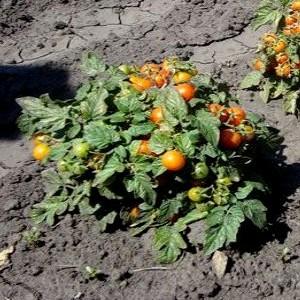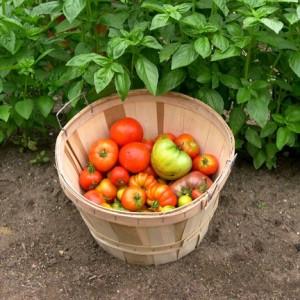How to grow tomatoes "Klusha"
The first question everyone asks when they know the name sweet tomatoes: why was the variety named Klusha? The image of a slow and clumsy woman immediately comes to mind. Is this really a characteristic of a hostess who can grow an excellent harvest of such tomatoes without hassle? You will find the answer to this question in our article, and at the same time you will learn all the most important about the Klush tomato variety.
The content of the article
Characteristics and description of the variety
The variety was bred relatively recently. But those who have already paid attention to it know why the tomato was given such a name. The reason was not at all the sluggishness of the owner of the garden. The main reason is that the name of the hen is the brood hen. A bush of tomatoes of this variety looks very much like a caring chicken with fluffy feathers on the wings, among which you can see tomato babies. Look at the photo and see for yourself:

The main characteristics of the variety:
| Characteristic | Description |
| general description | Medium early, determinant, undersized variety |
| Preferred growing location | Open ground |
| Description of the tomato bush | Stable, standard type, spreading in width |
| Feature of the structure of the bush | The crop is hidden under the leaves deep in the bush |
| Bush height | Up to 50 cm |
| Stealing | Not required |
| Fruit shape and color | Rounded, red |
| Fruit structure | Firm, fleshy, not watery |
| Fruit weight | Up to 150 g |
| Ripening period | From seed germination to the first harvests 90-100 days |
| Yield | 10-12 kg from 1 sq. m |
| Cold and disease resistance | Cold and disease resistant variety |
| How is it used | Consumed fresh, as well as for canning |
Pros and cons of the variety
Among pluses varieties Klusha tomato growers note:
- disease resistance;
- compact size of the bush;
- ease of care (does not require pinching);
- early ripening of fruits;
- a lot of fruits in the brush;
- universal use of fruits;
- suitable for growing in different climatic zones.
There are few disadvantages of the variety. Is that the abundant foliage, densely enveloping the fruits.
How to grow a tomato
Let's pay attention to the peculiarities of growing this tomato variety. In general, the care is standard: planting seedlings, watering, loosening, feeding. Since Klusha tomato bushes grow compact and dense, many do not tie them up. So that the fruits on an untied bush do not come into contact with the ground, the soil under the bush is covered with a thick layer of hay or straw (up to 10 cm). This will keep the crop from rotting and eating. pests.
Let's consider in order the stages of cultivation of Klusha tomatoes.
Soil preparation
The soil can be taken from two sources:
- take from your site;
- buy at a gardening store.
The soil from the store does not need to be processed. It can only be revised for the presence of large pebbles or non-rotten root residues. If they are, just delete them.
If soil is taken from your garden, it must be disinfected. There are three ways to do this:
- Heat on a baking sheet in the oven for 30 minutes at a temperature of 75-90 ° C.
- Spill the soil with boiling water.
- Dilute 1 g of potassium permanganate crystals in 5 liters of water and spill the earth with this solution.
Selection and processing of seeds
It is best to grow Klusha tomatoes through seedlings. This will allow you to get a tomato harvest in the early stages. To accelerate germination and growth, experienced gardeners are advised to treat the planting material with a growth and development stimulant (for example, with the drug "Epin").
Planting seedlings
Seeds are planted in the second half of March, 2 months before planting plants in a permanent place.
The seeding depth is 1.5-2 cm. The seed container in the ground is covered with plastic wrap. This creates an optimal microclimate for seedlings. Seeds germinate best in a warm place. The best temperature is 23-25 ° С. When the sprouts "hatch", the containers are taken out to a bright place. The first shoots appear about 5-9 days after sowing.
Then the seedlings are grown at home on a windowsill or in a special room, providing the seedlings with good illumination. Gently watered with settled water.
Seedling picking
When 1-2 true (not counting the cotyledons) leaves appear on small plants, the tomatoes are planted in separate containers. This process is called picking. Each plant has its own separate pot. You need to dive so that the plant has enough room for the development of the root system.
Important! After picking, tomato plants stop the growth of the aerial part for a while. At this time, there is a process of rooting and adaptation to a new place. When it ends, the plant will continue to grow.
Landing in the ground
Klusha tomato bushes are compact. Because of this, they can be planted somewhat closer to each other than other varieties. Planting density - 5-6 bushes per 1 sq. m.
Care, feeding, watering
Tomato - drought-resistant plant. In order for the roots to grow better and penetrate deeper into the soil, in the first week or two after planting in the ground, do not strive to water these tomatoes abundantly. The deeper the roots penetrate into the depths, the stronger the bush will hold in the ground.
Leaves on the bush will grow a lot. They will hide brushes with ripening tomatoes under them. After brushes with fruits are formed on the bush, tomato growers recommend removing the leaves above the brushes of tomatoes. This will direct all the nutrients to the ripening and growth of the fruit. But even if this is not done, the harvest will be decent.
It will not be superfluous to feed the tomatoes. Do either root top dressing (fertilize directly under the roots) or foliar top dressing (fertilize the aboveground part of the tomatoes).
On the bushes of tomatoes of the Klusha variety, foliar dressing with boric acid has proven itself well. How to make them? It's very simple: tomato bushes are sprayed from a spray bottle with a solution prepared at the rate of 0.5 teaspoon of boric acid crystals per 10 liters of hot water.
Important! The solution is used after it has cooled down.
Prevention of diseases and pests
The Klusha tomato bush is quite resistant to diseases. Prevention of diseases and pests consists in adhering to a crop rotation plan, pre-planting soil cultivation and measures to create conditions in which the bushes remain safe.
The smell will deter pests. For example, calendula, if you plant it next to tomatoes. Or the aroma from a solution of garlic (insist 250 g of chopped garlic cloves in 5 liters of water), which is sprayed with bushes so that pests do not like them.
Reviews of gardeners
We offer an overview of the reviews of those who have already grown Klusha tomatoes:
Alexander (Russia, Nizhny Novgorod region): “I grow it in the open field. All care comes down to watering. Not my stepson, I don't tie up. The only thing I do is put a high layer of hay under the bushes so that the fruits do not lie on the ground. I collected 8 buckets of tomatoes from 14 bushes. It is better not to use your own seeds, but to buy varietal seeds from the manufacturer. Tomatoes did not grow from my collected seeds. I recommend the variety. They say that there are also Superkluff tomatoes, and he is even cooler. I want to try. "
Victoria (Russia): “Gorgeous grade. Looks like a Crimson Dwarf. "
Valentina (Russia): "There is little care, but the harvest is decent."
Leonid (Russia, Ural): «I got a wonderful harvest. The tomatoes are not large, but a lot of them grow on the bush. "
Olga (Russia): “Yielding tomato. Delicious, hardy and unpretentious.Tomato met all expectations and confirmed all the praises available to his address. Suitable for beginner gardeners. I also want to try a variety of varieties - Superklushu. I read that they are very similar, only pink fruits grow.»
Let's sum up
The plant fully justifies the name by its appearance. The bush really looks like a hen, covering growing tomatoes with its wings. There is not much care for the bushes, and the yield of the variety pleases gardeners with its volumes. The fruits are eaten fresh and used for canning. Worth a try.